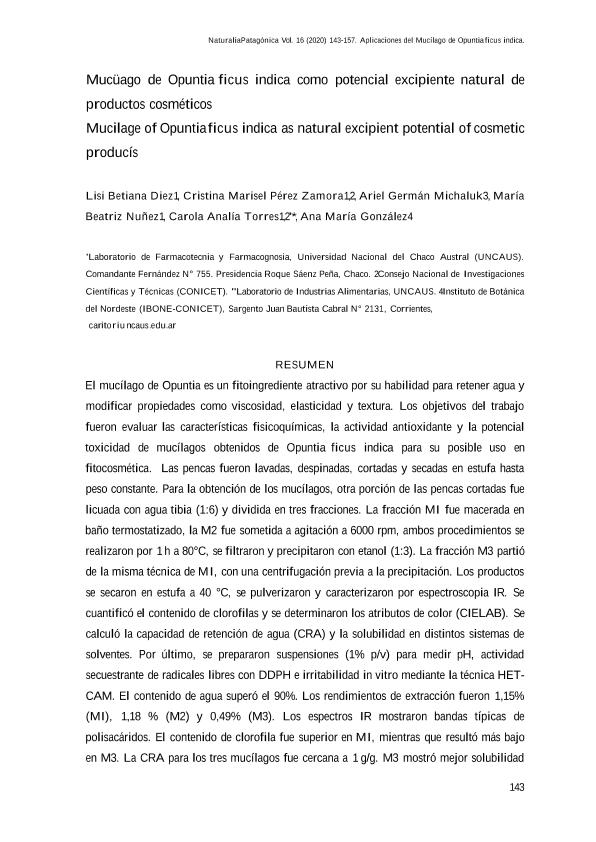Artículo
El mucílago de Opuntia es un fitoingrediente atractivo por su habilidad para retener agua ymodificar propiedades como viscosidad, elasticidad y textura. Los objetivos del trabajofueron evaluar las características fisicoquímicas, la actividad antioxidante y la potencialtoxicidad de mucílagos obtenidos de Opuntia ficus indica para su posible uso enfitocosmética. Las pencas fueron lavadas, despinadas, cortadas y secadas en estufa hastapeso constante. Para la obtención de los mucílagos, otra porción de las pencas cortadas fuelicuada con agua tibia (1:6) y dividida en tres fracciones. La fracción M1 fue macerada enbaño termostatizado, la M2 fue sometida a agitación a 6000 rpm, ambos procedimientos serealizaron por 1 h a 80°C, se filtraron y precipitaron con etanol (1:3). La fracción M3 partióde la misma técnica de M1, con una centrifugación previa a la precipitación. Los productosse secaron en estufa a 40 °C, se pulverizaron y caracterizaron por espectroscopía IR. Secuantificó el contenido de clorofilas y se determinaron los atributos de color (CIELAB). Secalculó la capacidad de retención de agua (CRA) y la solubilidad en distintos sistemas desolventes. Por último, se prepararon suspensiones (1% p/v) para medir pH, actividadsecuestrante de radicales libres con DDPH e irritabilidad in vitro mediante la técnica HETCAM.El contenido de agua superó el 90%. Los rendimientos de extracción fueron 1,15%(M1), 1,18 % (M2) y 0,49% (M3). Los espectros IR mostraron bandas típicas depolisacáridos. El contenido de clorofila fue superior en M1, mientras que resultó más bajoen M3. La CRA para los tres mucílagos fue cercana a 1 g/g. M3 mostró mejor solubilidadNaturalia Patagónica Vol. 16 (2020) 143-157. Aplicaciones del Mucílago de Opuntia ficus indica. en los distintos sistemas solventes. Todos los mucílagos presentaron un ángulo de tono (h*)amarillo-verdoso y alta luminosidad. Los valores de pH de las suspensiones estuvieron entre5,07 y 6,50. Si bien todos mostraron capacidad antioxidante, M2 presentó la mayor actividadde depuración. Ninguno resultó irritante. La agitación contribuyó a mejorar la actividadantioxidante y la centrifugación previa a la precipitación aumentó la solubilidad. Por lo tanto,en futuras extracciones se implementará una combinación de ambas técnicas. Opuntia mucilage is an attractive phytoingredient due to its ability to retain water and modify properties such as viscosity, elasticity and texture. The aims of this work were to evalúate the physicochemical characteristics, the antioxidant activity, and the potential toxicity of mucilages obtained from Opuntia ficus indica for its possible use in phytocosmetics. The cladodes were washed, de-stoned, cut, and put into a stove to constant weight. To obtain the mucilage, another portion of the cut cladodes was liquefied with warm water (1:6) and divided into three fractions. The MI fraction was macerated in a thermostatic bath, the M2 was stirred at 6000 rpm, both procedures were performed for 1 h at 80°C, filtered and precipitated with ethanol (1:3). For the M3 fraction the same technique was used as for MI but with a centrifugation before precipitation. The producís were dried in an oven at 40 °C, powdered and characterized by IR spectroscopy. Chlorophyll contení was quantifíed and color attributes (CIELAB) were determined. Water holding capacity (WHC) and solubility in different solvent Systems were calculated. Finally, suspensions (1% w/v) were prepared to measure pH, free radical scavenging activity with DDPH, and irritability in vitro by HETCAM method. The water content was over 90%. The extraction yields were 1.15% (MI), 1.18% (M2) and 0.49% (M3). IR spectra showed typical polysaccharide bands. The chlorophyll content was higher in MI, while it was very low in M3. The WHC for the three mucilages was cióse to 1 g/g. M3 showed better solubility in the different solvent Systems. All mucilages had a yellow-green tone angle (h*) and high brightness. The pH valúes of the suspensions were between 5.07 and 6.50. Although all showed antioxidant capacity, M2 presented the highest radical scavenging activity. None of them were irritating. Agitation contributed to improve antioxidant activity and centrifugation prior to precipitation increased solubility. Therefore, a combination of both techniques will be implemented in future extractions.
Mucílago de Opuntia ficus indica como potencial excipiente natural de productos cosméticos
Título:
Mucilage of Opuntia ficus indica as natural excipient potential of cosmetic
products
Diez, Lisi Betiana; Pérez Zamora, Cristina Marisel ; Michaluk, Ariel German
; Michaluk, Ariel German ; Nuñez, María Beatriz; Torres, Carola Analía
; Nuñez, María Beatriz; Torres, Carola Analía ; González, Ana María
; González, Ana María
 ; Michaluk, Ariel German
; Michaluk, Ariel German ; Nuñez, María Beatriz; Torres, Carola Analía
; Nuñez, María Beatriz; Torres, Carola Analía ; González, Ana María
; González, Ana María
Fecha de publicación:
03/2021
Editorial:
Universidad Nacional de la Patagonia San Juan Bosco
Revista:
Naturalia Patagónica
ISSN:
2591-6653
Idioma:
Español
Tipo de recurso:
Artículo publicado
Clasificación temática:
Resumen
Archivos asociados
Licencia
Identificadores
Colecciones
Articulos(IBONE)
Articulos de INST.DE BOTANICA DEL NORDESTE (I)
Articulos de INST.DE BOTANICA DEL NORDESTE (I)
Citación
Diez, Lisi Betiana; Pérez Zamora, Cristina Marisel; Michaluk, Ariel German; Nuñez, María Beatriz; Torres, Carola Analía; et al.; Mucílago de Opuntia ficus indica como potencial excipiente natural de productos cosméticos; Universidad Nacional de la Patagonia San Juan Bosco; Naturalia Patagónica; 16; 3-2021; 143-157
Compartir



